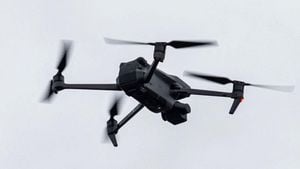Air travel is seeing improvements, or at least that's the impression many travelers have as they board flights this season. What seems like progress might just be airlines playing with numbers. Recent trends reveal airlines are adjusting flight schedules to appear more punctual, which is raising eyebrows among frequent fliers and industry experts alike.
Recent reports indicate airlines are adding extra time to their estimated flight durations, creating what is often referred to as "flight padding." This tactic allows flights to arrive on time more frequently, masking the actual delays occurring behind the scenes. Just think about it: when you see your aircraft landing later than the scheduled time, but still being marked as 'on time,' it starts to feel like someone’s pulling the wool over your eyes.
Chad Kendall, aviation professor at Metropolitan State University of Denver and former commercial pilot, elaborates on this phenomenon. "On average, airlines are adding about 20 minutes to schedules for what used to be two-hour flights. This means they can arrive even when they’re actually running late," he explains. It’s like playing the ultimate trick—making something appear longer just to beat the clock.
This strategy appears to be effective, as the numbers suggest fewer reported delays. According to the Bureau of Transportation Statistics, only 37% of flights experienced delays last year, down from 51% back in 1995. At the same time, trips take longer: the average departure delay increased from 8 minutes to 13 minutes over the same period. So, even as delays drop numerically, the individual experiences of passengers may still not align with their expectations.
Another traveler, Holly Brown-Borg, who frequently flies Delta Airlines, noted, "I think it’s great! It's less stressful to know my flight is probably going to arrive on time, even if it means I’m sitting at the gate longer." This reflects the paradox; passengers appreciate the on-time arrival—but at what cost?"
With all this padding going on, passengers may find themselves waiting longer, feeling reassured by the airline’s apparent punctuality but spending additional hours at the airport. More time spent can even lead to increased airport revenue, as they benefit from passengers exploring various vendors during their extended wait times.
Yet it doesn’t stop there. Industry dynamics have shifted, too; planes are smaller, flying more routes, complicates matters even more. This means more planes crowding the sky and congesting ground operations—leading to more potential delays once airborne. Traffic control is under pressure to navigate more aircraft, contributing to the increasing average taxi times, often adding more anxiety for fliers trying to make connections. Brown-Borg noted, "Taxiing times can now add 10 to 15 minutes to flights because airports are so busy now—it can be really frustrating."
There’s also this growing trend where passengers must arrive even earlier for their flights. Gone are the days of breezy arrivals just before boarding. Jonathan Boember, another frequent flyer, reminisced, "I used to walk straight to the gate at Denver International Airport. Now I make sure I’m at the airport at least two-and-a-half hours early for just a two-hour flight!" It creates this feeling of uncertainty—while you’re told your flights aren’t delayed, the total airport experience keeps stretching.
But why do passengers tolerate this? After decades of flying, many have come to expect longer waits, delays, and changes as part of the travel package. They hope the padded schedules are giving them just enough breathing room, cushioning their journeys against unplanned issues. The reality is, the more passengers accept these alterations, the more airlines feel empowered to adjust their expectations.
The airlines, naturally, appreciate this convenient shift. On the surface, everything looks good; flights are coming within their predetermined schedules, encouraging satisfied flyers to return. What airlines might not fully understand is the undercurrent of frustration bubbling among seasoned travelers who recognize what's going on and feel stifled by these new normal airplane travel realities.
The effectiveness of these strategies is not without critique though. Some industry analysts argue this practice might be undermining long-term trust between airlines and their passengers. It’s a slippery slope when comfort and convenience clash with transparency and honesty. Will airlines risk their reputations for short-term gains? Only time will tell.
So, as more people begin to fly again and travel becomes part of everyday life once more, the nature of air travel continues to evolve. The focus on efficiency might just be shifting away from ensuring timely departures and arrivals to managing perceptions, keeping passengers feeling good even when the actual experiences tell another story. Isn’t it ironic? Airlines are tuning their performance metrics to reflect light at the end of the tunnel, but the tunnel seems to keep getting longer.



